
The Lake Vermilion-Soudan Underground Mine State Park is a Minnesota state park at the site of the Soudan Underground Mine, on the south shore of Lake Vermilion, in the Vermilion Range (Minnesota). The mine is known as Minnesota's oldest, deepest, and richest iron mine. It formerly hosted the Soudan Underground Laboratory. As the Soudan Iron Mine, it has been designated a U.S. National Historic Landmark.

The B'nai Abraham Synagogue is a former Jewish congregation and synagogue, now repurposed as a Jewish history museum and performance venue, located in Virginia, Minnesota, in the United States. It was constructed in 1909 as the first purpose-built synagogue on the Iron Range. It served as the heart of the local Jewish community in the early 20th century. The building was listed on the National Register of Historic Places in 1980 for its local significance in the themes of religion and social history. It was nominated for attesting both to the ethnic diversity of the Iron Range and to the commonality of its immigrant groups maintaining cohesion around religious centers.

Two Harbors station is a historic train station located on Sixth Street in Two Harbors, Minnesota. The station was built in 1907. The large two-story depot was the third depot on the site. The Minnesota Iron Company developed the Duluth and Iron Range Railroad in 1883, laid out the town of Two Harbors in 1885, and built depots to conducts its business. When the rail line was completed to Duluth, it was used as a transfer point for passengers, lumber, and mining supplies. When passenger service ended in 1961, the depot was donated to Lake County. The building was listed on the National Register of Historic Places in 1983 as the Duluth and Iron Range Railroad Company Depot.

Crosby station is a historic former train station in Crosby, Minnesota, United States. It was established in 1910. It was listed on the National Register of Historic Places in 1980 as the Crosby Railroad Depot for having local significance in the themes of commerce, industry, and transportation. The depot was nominated for being an essential conduit for the arrival of goods and people and the export of iron ore during central Crow Wing County's economic boom years.
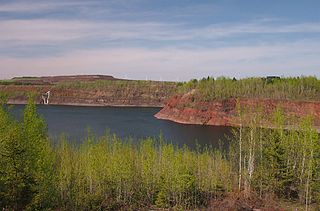
Mountain Iron Mine is a former mine in Mountain Iron, Minnesota, United States. Opened in 1892, it was the first mine on the Mesabi Range, which has proved to be the largest iron ore deposit ever discovered in the United States. Mining operations at the site ceased in 1956. The bottom of the open-pit mine has filled with water but its dimensions are readily visible. The city maintains an overlook in Mountain Iron Locomotive Park.
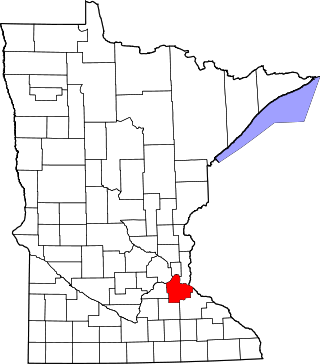
This is a list of the National Register of Historic Places listings in Dakota County, Minnesota. It is intended to be a complete list of the properties and districts on the National Register of Historic Places in Dakota County, Minnesota, United States. Dakota County is located in the southeastern part of the U.S. state of Minnesota, bounded on the northeast side by the Upper Mississippi River and on the northwest by the Minnesota River. The locations of National Register properties and districts for which the latitude and longitude coordinates are included below, may be seen in an online map.

This is a list of the National Register of Historic Places listings in Saint Louis County, Minnesota. It is intended to be a complete list of the properties and districts on the National Register of Historic Places in Saint Louis County, Minnesota, United States. The locations of National Register properties and districts for which the latitude and longitude coordinates are included below, may be seen in an online map.

This is a list of the National Register of Historic Places listings in Crow Wing County, Minnesota. It is intended to be a complete list of the properties and districts on the National Register of Historic Places in Crow Wing County, Minnesota, United States. The locations of National Register properties and districts for which the latitude and longitude coordinates are included below, may be seen in an online map.

Ironton Sintering Plant Complex is a group of buildings north of Crosby, Minnesota, United States, listed on the National Register of Historic Places. The plant was built in 1924 by the Hanna Mining Company to sintering iron ore mined in the Cuyuna Range. The mining industry, after 1900, was seeking to exploit lower-grade iron deposits to meet the increasing demand of the iron and steel industry. To bring the ore to customers' specifications, the mines sought to "beneficiate" the ore through sintering, crushing, and washing. The sintering process was unique to the Cuyuna Range and made it possible to economically support mining.

Hibbing High School is a public school, grades 7–12, in Hibbing, Minnesota, United States. It was built from 1920 to 1922 as the entire city relocated two miles (3 km) south to make way for the expanding Hull–Rust–Mahoning Mine. The lavish Tudor Revival building was constructed at a cost of about $3.9 million, becoming known as the "castle in the woods" and—thanks to its polished brass fixtures—the "school with the golden doorknobs". The project was bankrolled by the mining industry, which wanted to make the move more palatable for those being displaced. It also satisfied immigrants' desire for their children's education.
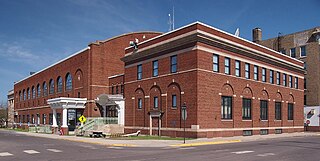
The Virginia Recreation Building is a former community center in Virginia, Minnesota, United States, that was later converted into a factory. It was designed by architect Frederick German and built in 1923 as an ice hockey and curling rink to provide a public venue for physical development to the working class men largely employed in Iron Range mines. A generation later, as the gender balance of the city's population evened out, the building was converted into a shirt factory in 1947 to create jobs for women. The building was listed on the National Register of Historic Places in 1982 for its state-level significance in the themes of industry and social history. It was nominated for encapsulating the social welfare of the Progressive Era and the robust public spending funded by the mining boom, and the transition to a more gender-balanced population and need to diversify the economy.

The Virginia–Rainy Lake Lumber Company Office is a former office building in Virginia, Minnesota, United States. It was built around 1907 as the headquarters for the Virginia–Rainy Lake Lumber Company, the largest lumber company in the Upper Midwest in the early 20th century. The building was listed on the National Register of Historic Places in 1980 for its state-level significance in the theme of industry. It was nominated for representing one of the Iron Range's few major industries aside from mining.
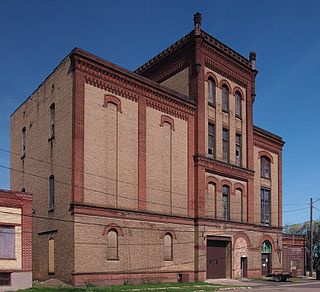
The Virginia Brewery is a former brewery in Virginia, Minnesota, United States. It was built in 1905 and closed during Prohibition. The building was listed on the National Register of Historic Places in 1980 for its local significance in the themes of architecture, commerce, and industry. It was nominated for being a distinctive example of the local breweries that contributed to economic and social life of the Iron Range before Prohibition and competition from larger brands put them out of business.

Tower Fire Hall is a former fire station in Tower, Minnesota, United States. It was built around 1895 as the first fire station on the Iron Range, when the wooden construction, crowded lots, and inadequate plumbing infrastructure of the early mining boomtowns made fire a particular danger. Tower Fire Hall was listed on the National Register of Historic Places in 1980 for its local significance in the theme of social history. It was nominated for reflecting the region's serious danger of and response to fires.

Tanner's Hospital, later known as Carpenter's Hospital, is a former hospital building in Ely, Minnesota, United States. It was built in 1901 as a moneymaking enterprise due to the high disease rate in the area. This was a consequence of low investment in sanitation infrastructure in the mining boomtowns of the Iron Range, where the long-term existence of any given community was unpredictable. It was later converted into the "Lakeview" apartments that existed from the 1950s to the 1980s. Tanner's Hospital was listed on the National Register of Historic Places in 1980 for its local significance in the themes of architecture, commerce, and health/medicine. It was nominated as an emblem of this early period of entrepreneurial medicine before health and wellness were seen as public concerns.

The Finnish Sauna is a former public bath in Virginia, Minnesota, United States. It opened around 1912 to cater to urban Finnish Americans who wished to maintain the Finnish sauna tradition. It was listed on the National Register of Historic Places in 1980 for its local significance in the themes of architecture and social history. It was nominated for representing the strong influence of Finnish American culture on the Iron Range, and the commercial services developed to perpetuate it.

The East Howard Street Commercial Historic District is a historic business district in Hibbing, Minnesota, United States. It comprises both sides of East Howard Street along the four blocks between 1st and 5th Avenues. It was the new business district designed and built for Hibbing by the Oliver Iron Mining Company from 1920 to 1921, when the company arranged to move the city a mile south to expand the Hull–Rust–Mahoning Open Pit Iron Mine. The district was listed on the National Register of Historic Places in 1993 for its local significance in the theme of community planning and development. It was nominated as a key portion of Hibbing that represents the efforts of the Oliver Iron Mining Company to relocate the entire town, and the economic importance of iron mining on the Mesabi Range.

The Virginia Depot is a former train station in Virginia, Minnesota, United States. It was built in 1913 by the Duluth, Winnipeg and Pacific Railway. The station was listed on the National Register of Historic Places as the Duluth, Winnipeg, and Pacific Depot in 1980 for its local significance in the themes of architecture, commerce, and transportation. It was nominated as a distinctive symbol of Virginia's importance as a major entry point to the Mesabi Range, and of the region's dependence on rail transport to deliver goods and workers and ship out ore.

The Coates House is a historic house in Virginia, Minnesota, United States. It was built around 1912 as one of the city's larger and finer residences. A succession of prominent people in the local lumber industry lived in it. The house was listed on the National Register of Historic Places in 1980 for its local significance in the themes of architecture and social history. It was nominated for demonstrating the class distinctions telegraphed by housing stock on the Iron Range at the turn of the 20th century. Large houses for the managerial class provided a sharp contrast to the boarding houses and small cottages into which the period's working class population was crowded.
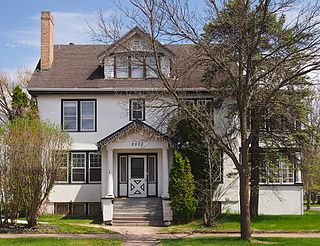
The Emmett Butler House is a historic house in Hibbing, Minnesota, United States. It was built in a simplified Colonial Revival mode in 1916 for Emmett Butler, a local leader and an executive in Minnesota's influential Butler Brothers Construction Company. The house was listed on the National Register of Historic Places in 1980 for its local significance in the themes of architecture and industry. It was nominated as an example of the Colonial Revival houses built in Minnesota in the early 20th century and for its associations with Butler.
























